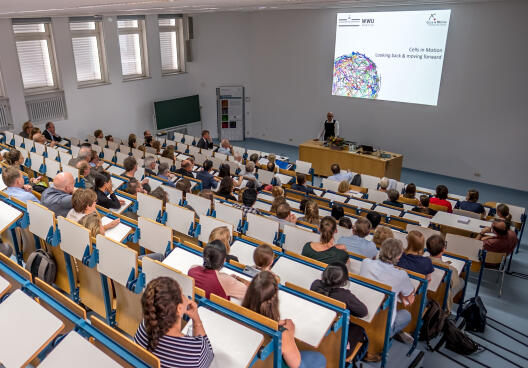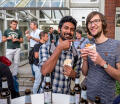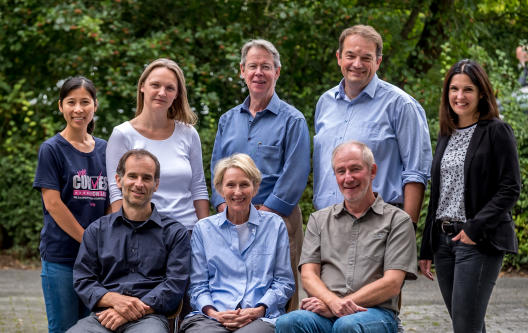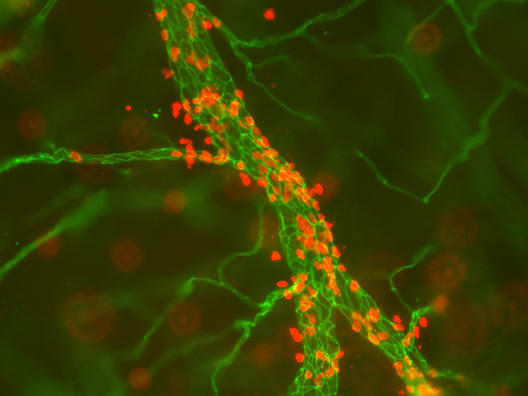“What our network creates is far more than the sum of our parts”
Photos


Rector Prof Johannes Wessels opened the subsequent ceremonial programme. He emphasised that Cells in Motion was a blueprint for how interfaculty research should be carried out at a university. The newly acquired infrastructures, he said, were bringing together researchers across faculty boundaries both intellectually and physically, thus shaping the research process. Wessels also underlined how Cells in Motion was setting examples in innovative teaching and excellent public outreach.© Uni MS/Thomas Hauss 
Physicist Prof Joachim Spatz from the Max Planck Institute of Medical Research in Heidelberg has been involved in Cells in Motion for many years as a member of the External Advisory Board. He underlined the extent to which the speakers had reported on knowledge they had gained from cooperation with colleagues from other working groups and disciplines. “You really did cross borders,” he said. The community was well-prepared to be successful in upcoming funding competitions.© Uni MS/Thomas Hauss 
Long-standing members of the research network from the five faculties involved at Münster University and from the Max Planck Institute shared their personal “Cells in Motion moments” with the guests: here, neurologist Prof. Sven Meuth, Dean of the Faculty of Medicine.© Uni MS/Thomas Hauss 
Personal anecdotes and stories put a smile on the guests’ faces.© Uni MS/Thomas Hauss 
Repeatedly, the speakers underlined the special team spirit at Cells in Motion: here, computer scientist Prof Xiaoyi Jiang, Dean of the Faculty of Mathematics and Computer Science.© Uni MS/Thomas Hauss 
In numerous examples they illustrated just how much the disciplines involved profited from one another: here, physicist Prof Cornelia Denz.© Uni MS/Thomas Hauss 
The network brought people together to work for a common goal, said molecular biologist Prof Ralf Adams, Managing Director at the Max Planck Institute (not in the picture). This would continue to enrich science in Münster – independently of any funding as a Cluster of Excellence, he added.© Uni MS/Thomas Hauss 
Chemist Prof Uwe Karst (not in the picture) also emphasised that Cells in Motion had established a culture that would endure. All those involved were extremely motivated to work together, he said, because they could see the benefits.© Uni MS/Thomas Hauss 
“Cells in Motion is a source of pleasure and is fun,” said biologist Prof Christian Klämbt. He also said that the network had created a scientific hotspot that is recognised both in Germany and internationally.© Uni MS/Thomas Hauss 
Without the three Coordinators of the Cluster – Prof Lydia Sorokin, Prof Volker Gerke and Prof Michael Schäfers – driving it, all this success wouldn’t have been possible, said Rector Prof Johannes Wessels.© Uni MS/Thomas Hauss 
Prof Lydia Sorokin, spokesperson for the Cluster, told how, as a new arrival in Münster during the early days of the Cluster initiative, she suddenly found herself part of the team of Coordinators and was wondering how she got involved. But she realised very quickly that the trio complemented each other perfectly, both scientifically and personally, and that they listened and learned from each other.© Uni MS/Thomas Hauss 
The three Coordinators looked back, with the guests, at the beginnings of the Cluster of Excellence and explained how the research concept developed – along with friendships too. They shared some funny and also some touching memories with the guests – from team-building activities and reviews by the commission of experts at the German Research Foundation to the recruitment of new colleagues. They also gave an overview of the many successful activities carried out by the Cluster of Excellence which have made a lasting impact – and the prospect of many of these being continued. © Uni MS/Thomas Hauss 
The guests enjoyed the evening …© Uni MS/Thomas Hauss 
… with a food truck …© Uni MS/Thomas Hauss 
… and live music.© Uni MS/Thomas Hauss 
© Uni MS/Thomas Hauss 
© Uni MS/Thomas Hauss 
© Uni MS/Thomas Hauss 
© Uni MS/Thomas Hauss 
© Uni MS/Thomas Hauss 
© Uni MS/Thomas Hauss 
© Uni MS/Thomas Hauss 
© Uni MS/Thomas Hauss 
© Uni MS/Thomas Hauss 
© Uni MS/Thomas Hauss 
© Uni MS/Thomas Hauss 
© Uni MS/Thomas Hauss
At a ceremonial symposium held on Monday (2 September), researchers from the University of Münster presented highlights of their research in the Cells in Motion Cluster of Excellence. This also marked the transition to a new phase for the research network: the Cells in Motion Interfaculty Centre, a central research institute at the University will continue the research carried out in the Cluster of Excellence, the funding for which ends in October 2019 after seven years. The network brings together and supports researchers from the fields of medicine, biology, chemistry, pharmacy, mathematics, computer science and physics to investigate how cells in organisms behave through the use and development of innovative imaging.

Yesterday, representatives from the five faculties involved, and from the Max Planck Institute of Molecular Biomedicine in Münster, came together for the constituent meeting. They confirmed the existing trio at the head of the Cluster of Excellence – Prof Lydia Sorokin, Prof Volker Gerke and Prof Michael Schäfers from the field of medicine – as well as Prof Dietmar Vestweber as the representative of the Max Planck Institute – in their positions as Executive Board members. Additionally, the community voted new people onto the leadership team. These include biochemist Prof Andrea Rentmeister and biologist Prof Stefan Luschnig who head two of the 13 research groups newly established through Cluster of Excellence funding, strengthening disciplines central to the area of research. Other new members of the Executive Board are mathematician Prof Benedikt Wirth; pharmacist Dr Anna Junker; Tu Nguyen, a PhD student in biology; and Doris Niederhoff, Science Communication Manager. Administrative Manager Dr. Christiane Natsch is an advisory member.

In the two-stage competition for an additional funding phase as part of the Excellence Strategy of the national and regional state governments in Germany, Cells in Motion was one of the 88 Clusters – out of 195 – that were successful in the first round. Ultimately, however, the Cluster was not selected for further funding. Irrespective of the result of the Excellence Strategy competition, the University of Münster’s Senate had already decided in January 2018 to maintain the interdisciplinary research concept long term, in the form of an interfaculty institution. “We are still convinced that our strengths lie in interdisciplinary research,” says Prof Johannes Wessels, Rector of the University of Münster. “The Cluster of Excellence has invested a lot into establishing structures that not only link the different disciplines involved in a long-lasting way, but also provide a long-term foundation for the ‘Cell Dynamics and Imaging’ profile area at the University of Münster.” The network’s concept, he added, fitted perfectly into the University’s future concept of close cooperation between research, the promotion of junior researchers, science communication and research infrastructure.
“Our research and training network has grown over the years, creating a structure that is much more than the sum of our individual parts,” says Lydia Sorokin. “We are now in a good position to develop new strengths for future excellence competitions and to compete for other sources of collaborative research funding. Some such applications have already been submitted by members of our community and are currently being reviewed.” The work in the network is still in full swing, she adds: “For example, in our graduate programme; together with 30 principal investigators from all the faculties involved, we have just assessed applications from 650 students from all over the world and selected the 19 most promising junior researchers.” A total of 100 doctoral students are currently engaged in research in the programme.
Activities and infrastructure of the Cells in Motion Interfaculty Centre
Weekly series of events provide opportunities for researchers at all stages of their careers to exchange ideas in the field of cell dynamics and imaging with colleagues from other disciplines and to establish contacts, both within the University and outside. In one series of lectures, established researchers in the network and renowned guests from all over the world present innovative research ideas and new findings. At the Brown-Bag Lunches junior researchers present and discuss their research projects. Career networks will continue to provide individualized advice and support to early stage researchers.
In the CiM-IMPRS graduate programme, PhD students will continue to carry out research in the interdisciplinary field of cell dynamics and imaging, undergoing structured, specialized training to promote development of subject-specific skills, and will acquire key cross-disciplinary qualifications. Additionally, a variety of funding programmes for doctoral students and post-docs will be be continued and further developed by the newly elected Research and Careers Committee. In interdisciplinary teams, for example, junior researchers will be able to submit funding applications for their own first research projects. Scholarships for research periods in external teams and for participation in specialist conferences will provide junior researchers with opportunities to learn new methods, present their work among experts, and to develop international connections.
The Imaging Network, a cooperation network for biomedical imaging, supports the joint use of imaging infrastructure by researchers from various institutes and faculties, and promotes the development of imaging technologies and infrastructure at the University of Münster. Through the network, researchers efficiently share equipment, methods and expertise. The current focus is on microscopy and will be extended to preclinical imaging in future.
The Cells in Motion Interfaculty Centre will also continue to support researchers to provide the public with insights into research, making knowledge accessible in various forms and in a clear and, at the same time, sufficiently detailed manner.
In the future, a new research building, the Multiscale Imaging Centre, currently under construction in Röntgenstraße in Münster, will be the central site for lectures, symposia and for members’ meetings. Core equipment and technologies for biomedical imaging and associated research teams will be situated in the building, together with the science management and science communication teams.

